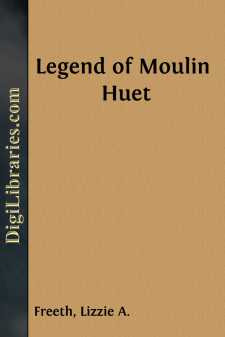Categories
- Antiques & Collectibles 13
- Architecture 36
- Art 48
- Bibles 22
- Biography & Autobiography 813
- Body, Mind & Spirit 142
- Business & Economics 28
- Children's Books 17
- Children's Fiction 14
- Computers 4
- Cooking 94
- Crafts & Hobbies 4
- Drama 346
- Education 46
- Family & Relationships 57
- Fiction 11829
- Games 19
- Gardening 17
- Health & Fitness 34
- History 1377
- House & Home 1
- Humor 147
- Juvenile Fiction 1873
- Juvenile Nonfiction 202
- Language Arts & Disciplines 88
- Law 16
- Literary Collections 686
- Literary Criticism 179
- Mathematics 13
- Medical 41
- Music 40
- Nature 179
- Non-Classifiable 1768
- Performing Arts 7
- Periodicals 1453
- Philosophy 64
- Photography 2
- Poetry 896
- Political Science 203
- Psychology 42
- Reference 154
- Religion 513
- Science 126
- Self-Help 84
- Social Science 81
- Sports & Recreation 34
- Study Aids 3
- Technology & Engineering 59
- Transportation 23
- Travel 463
- True Crime 29
Legend of Moulin Huet
by: Lizzie A. Freeth
Categories:
Description:
Excerpt
CHAPTER I.
In the year 165–, when Cromwell had gained ascendancy in England and over the greater portion of the Channel Islands, there lived in Guernsey, at the Bay of Moulin Huêt, a miller of the name of Pierre Moullin. Unlike his class generally, he was a very morose man, hard in his dealings with the poor around him, and exceedingly unsympathizing in all his domestic relations, as will appear as our story unwinds itself. Before speaking of the family surroundings of Pierre Moullin we will glance at the circumstance which forms the basis of the present tale. Visitors to the Bay of Moulin Huêt, as well as to other parts of this and the surrounding Islands, may have observed a crimson appearance on the rocks, suggesting very sanguinary ideas, but for which, geologists doubtless, would be able to account in a very satisfactory manner. Looking at a portion of the original gully through which the water runs after passing through the mill wheel, we find that this crimson appearance is very visible, and as our purpose is not to raise scientific enquiries, we will take one of the fanciful reasons (of which there are two or three in existence), for this coloring on by the hand of Nature, which has so abundantly bedecked Guernsey in general, and Moulin Huêt in particular. Dipping into the Fairy lore of that part of the island, we find that many believe that some mischievous Fairies who annoyed the miller much with their nightly pranks were ground to pieces by the mill wheel becoming unfastened, and that their blood remains there to this day, as a warning to all others among the "good people" who might wish to vent their superfluous mischief in a like manner.
So much for the Fairy lore in the Moulin Huêt Chronicles; but we must turn our attention elsewhere to find out whose blood it was that thus dyed the watercourse of the Moulin Huêt Mill.
At the time of which we are speaking, (the opening of the year 165–) Pierre Moullin and his two children, a son and a daughter, lived in a house adjoining the mill, in fact, the same roof covered both mill and house, which were built facing the sea. The stream of water which turned the wheel was far more powerful than the present, as the old marks (still partially visible) denote. Pierre Moullin, like many of his fellow-islanders, was a strong adherent of Cromwell; his son Hirzel was also,—though perhaps he did not go quite as far as his father in his hatred of the Royalist party. He had nevertheless acquaintances among the Royalist soldiers who were quartered in the strong fortress at Jerbourg. One in particular he had made a great friend of—Charlie Heyward. Old Pierre often used to say he knew harm would come of this friendship, and felt his words were being proved true when he discovered that an attachment was springing up between his daughter Marguerite and the young soldier. On becoming aware of this his rage was unbounded, and he repeatedly said he would be the death of Charlie if he could manage it. He tried in every way to bring his son to his way of thinking, but though Hirzel did not much like the idea of his sister marrying a Royalist soldier, and besides which another friend and fellow-countryman of his Jacques Gaultier, was also much attached to the fair Marguerite, and had long persecuted her with his unwelcome attentions, still Hirzel would have done anything rather than have injured his friend Charlie, whom he liked well, though he did not like his principles....


